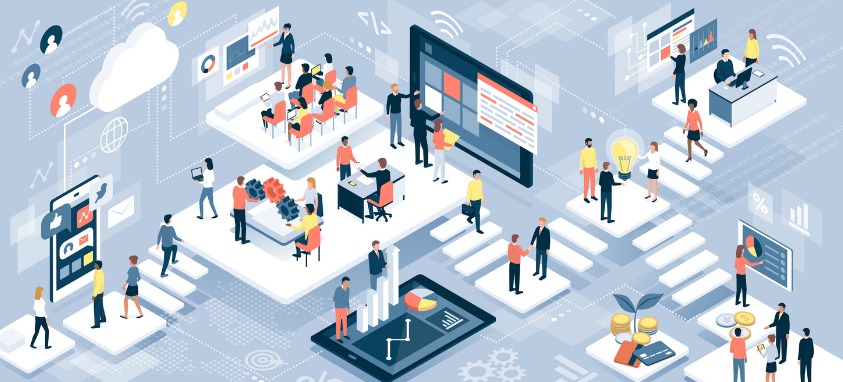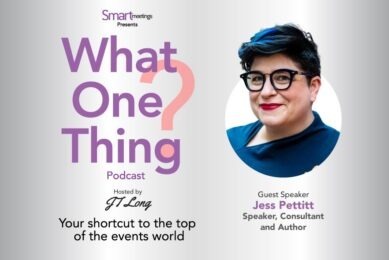(What worked in lockdown is worth keeping)
In a recent edition of this column, we discussed the five habits to break in your online events, as well as our in-person events. As good as it is to reflect from time to time and analyze what practices from the pandemic should be weaned or flung off entirely, it’s equally important to look back at recent events and see what’s working.
And while it’s understandable we often focus on the negative of the last 18 months, and easy to have a pull towards “that which we were doing before,” there are important lessons that should be top-of-mind as we reincorporate in-person experiences into our meeting and event options.
1. A Voice for Everyone, Including Those Without One
Almost every negative event brings with it the possibility of silver linings. When the pandemic hit, and the lockdowns began, the industry was forced to take events online in unprecedented numbers. When that happened, people with mobility issues found themselves—many for the first time in their lives—on level ground with their fellow attendees. Those that found it difficult to travel across town (much less get on a plane and fly thousands of miles to navigate hotels, venues and transportation that may, or may not, be accessible) could suddenly attend events from the comfort of their homes and offices, just like the rest of us.
While so many bemoaned the loss of the in-person experience, for others it was a chance to finally attend events in the first place.
And this went far beyond people with mobility issues. Technology like automated captioning and transcription, while far from perfect, offered easy entry for not only people with hearing impairments but also for those for whom the conference was not speaking their native language. Digital events offer lower barriers of entry for people from all over the world, from all walks of life, from all types of voices, from all levels of mobility, speech, sight and spirit.
More: Designing Your Event Program for Diversity & Inclusion
While even before the pandemic companies and organizations were making moves to make their groups more diverse and inclusive, online events have the power to propel those goals forward in spectacular fashion. Those that rush back to “what was before,” specifically in-person events with little-to-no digital experience, risk leaving all those voices behind, and I sincerely hope we take a good look at our in-person experiences with a fresh eye for accessibility.
2. But Seriously, Could It Have Been an Email?
The “this could have been an email” meme has been around for a while now, and concisely represents the idea that not every topic needs to be discussed in person—something proven out by pandemic-era meetings. Companies and organizations around the world kept on innovating, releasing products, and not only kept the lights on but in many cases even saw record profits with the majority of their workforce at home. Organizations found themselves with enormous decreases in travel costs and reduced losses in productivity due to time OOO.
But the real winner was Mother Nature….
Executives learned they didn’t need to fly from coast to coast to seal every deal, and diverse and worldwide workforces didn’t have to fly to a single location to get the Q2 financial update. By having fewer in-person meetings, you can significantly reduce the carbon footprint of your organization. This trend is also showing itself in site visits and venue selection. Planners are realizing virtual tours might be enough for the first round of the selection process, dramatically reducing their need to travel to venue candidates.
At the recent FICP (Financial & Insurance Conference Professionals) annual conference, I heard multiple venue representatives mention that new reality, including a $2 million group that booked a venue without ever setting foot on the property. Considering the thousands of site visits that take place each year, even removing one trip from the process can have tremendous impact on the environment—and that money can be invested in making remaining in-person experiences even more special.
3. Location, Location, Location
Speaking of venues, there’s another important lesson to be found there. When the pandemic hit, planners were forced to take their events to a venue type they might not have ever considered before: online platforms. They were forced to stretch waaaay beyond their comfort zones, and while it was painful, the industry as a whole stepped up to the challenge.
On more than a couple of events, I heard comments from attendees like “best annual meeting ever, online OR in person!” I sincerely hope planners emerge from the pandemic with a renewed sense of confidence that they can put on an amazing event literally anywhere, even in cyberspace.
Now that those digital venues are part of the toolkit, keep them there, and keep an open mind as to when they might be the most appropriate venue for your event. When it comes to physical locations, maybe we can be a little more experimental there, too? Hotels and resorts will always be a staple, but attendees are already saying it’s all about the in-person experience, so it’s time to take them to new and exciting places.
These locations often have their own challenges, but hey—you’ve got this! If you can take your annual conference online in fewer than six weeks, you can figure ways to get around those challenges.
4. Get the Best of the Best to Present
Another interesting side effect of the Great Online Migration of 2020 was that celebrities and high-end keynote presenters discovered they could work more and travel less. Flying to a location to speak is usually at least a day-and-a-half endeavor, but when it came to online events, they could sometimes even get in a couple per day. Many invested in cameras, microphones and lighting, finding they were able to deliver presentations of equal quality (and occasionally better quality) without leaving their office or home.
On the flip side, organizations found they were able to get higher-caliber presenters for less money due to the lack of travel and lower fees for remote presenters. Celebrities, politicians, top-of-their field medical professionals—they’re all more likely to “stop by” your event if it doesn’t involve having to take travel time out of their busy schedules.
Keep a close eye on this trend, as well as an increase in “remote presentation studios” where presenters can go to a professional streaming studio in their home cities, or wherever they may be in the world, the day of your event.
5. Know Your Audience Better Than They Know Themselves
Pre-pandemic, only a few organizations and planning teams understood the incredibly valuable data buried just underneath the surface of a typical event. Moving online exposed that data for the first time to a much larger group, and many organizations now have a taste of that data’s power and will never go back.
Whether in person or online, events hold a treasure trove of data for exhibitors (not only who stopped by the booth, but also those who didn’t yet likely would be interested in their products based on breakouts they went to), for sponsors (not just the list of attendees, but precisely how many watched their video or clicked on their banner), for attendees (here’s a post-event report with all the sessions you went to, as well as all the networking connections you made), and, of course, for planners.
More: Event Marketing Data: A Roaring 20s Is, Indeed, Emerging
This data isn’t just for your sales team and exhibitors. It’s for you, planners! Don’t just think you know what your attendees’ goals and objectives are, know it. Hard data about what your attendees actually do at your events is going to be far more telling than any post-event survey. Remember, to make something better, you first must be able to measure it. Figure out a way to attach concrete numbers to the goals of the event, then use data to figure out how to improve those numbers and enhance ROI for everyone involved.




